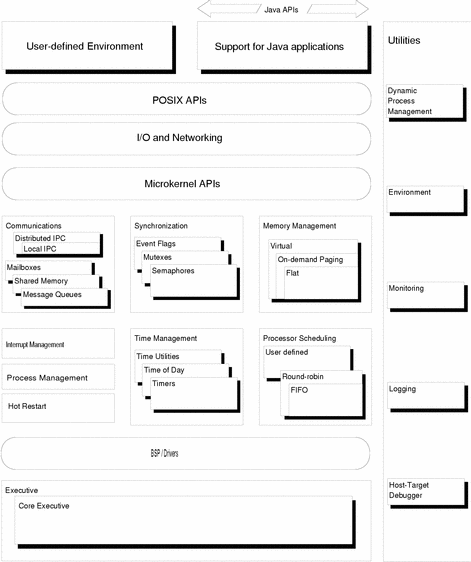Configurability
The ChorusOS operating system uses a flexible, component-based architecture that allows different services to be configured into the runtime instance of the ChorusOS operating system. This allows the runtime instance of the ChorusOS operating system to be finely tuned according to the underlying hardware platform, the memory footprint requirements, and the application features.
Essential services required to support real-time applications running on the target system are provided by the core executive, and each optional feature of the operating system is implemented as a separate runtime component that can be added to, or removed from the operating system, as required. This means that the operating system can be configured very accurately to meet the exact needs of a given application or environment, saving on memory and improving performance. Additional components can be added, to create a tailor-made instance, to the level of the resources available.
The core executive can support multiple, independent applications running in both user and supervisor memory space. The core executive can be complemented with additional components to add the features required to support a given application. Additional components supplied by the Sun Embedded Workshop software include:
-
Framework and drivers for building board support packages
-
Interrupt management
-
Processor scheduling
-
Synchronization
-
Memory management
-
Communications
-
Time management
-
File systems
-
Network protocols
-
Dynamic process management
-
POSIX application programming interfaces (APIs)
-
Support for Java applications
This flexible architecture is shown in Figure 2-2.
Figure 2-2 The ChorusOS Component-based Architecture

Detailed descriptions of the optional features for the ChorusOS operating system are provided in the ChorusOS 5.0 Application Developer's Guide.
By taking advantage of the component-based architecture, the application developer can choose between an extremely small operating system that offers simple scheduling and memory options, or a fully-featured, multi-API software platform.
As well as making it possible to produce multiple versions of the operating system, each of which is optimized for its own environment, the component-based architecture provides the following additional benefits:
-
Applications developed to run on a minimal configuration can also run unchanged on a more complex configuration, thus providing an evolutionary path for right-sizing devices and systems.
-
The programming interfaces for the operating system components are available publicly, providing an open environment for combining third-party system software and development tools.
Configuration Profiles
The ChorusOS operating system provides two standard configuration profiles. These serve as starting points for defining your own configuration:
-
Basic profile
-
Extended profile
Basic Profile
The basic profile is an example of a small deployment system and defines a realistic configuration while keeping the footprint as small as possible. When using the basic profile, all applications are usually embedded in the system image and launched either at boot time as boot applications, or subsequently from the file system.
Extended Profile
The extended profile is an example of a development system and should be viewed as a reference configuration for telecommunications systems. It includes support for networking using remote Inter-Process Communication (IPC) over Ethernet and a Network File System (NFS) client, using the protected memory model. It allows the development and loading of multi-actor applications. These actors may use any ChorusOS API, provided that the corresponding feature is part of the system configuration.
- © 2010, Oracle Corporation and/or its affiliates
